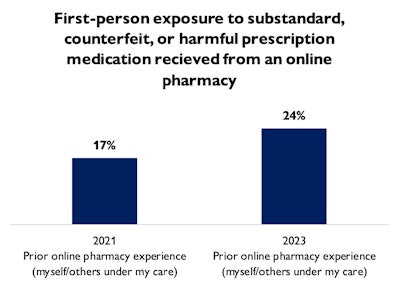
Each year, more Americans turn to online pharmacies for their medication needs. This trend, revealed by a recent survey conducted by ASOP Global [Alliance for Safe Online Pharmacies], brings with it potential risks associated with online drug purchases that fall outside the bounds of the regulated U.S. supply chain. Particularly worrisome is the sentiment that Americans are increasingly conflating prescription medicines with “any old consumer product, which creates a major risk in how healthcare is delivered in this country,” according to Justin Macy, director of innovation of the National Association of Boards of Pharmacy (NABP) and Board Chair of ASOP Global Foundation. (View the Americans’ Perception and Use of Online Pharmacies Survey here.)
The survey found that the majority (52%) of Americans have now purchased medication from an online pharmacy—a 10 percentage point increase from the previous survey. This includes prescription drugs for infection, pain, weight loss (which have skyrocketed in popularity), and more.
While the increase in online purchasing is not surprising given the growth of e-commerce across all sectors, the rise in online pharmacy use is outpacing the rate of legitimate prescription drug use across the country. 71% of respondents who use online pharmacies started within the last three years, indicating a significant shift towards digital platforms for obtaining medications.
The survey, which is the third edition in four years, allows for a longitudinal analysis of changing behaviors. It focused on five key areas:
1. The prevalence and patterns of online pharmacy use
2. Awareness of online pharmacy regulations and best practices
3. Motivations and behaviors
4. Risks and perceptions
5. Comfort with controlled substance telehealth regulations
Primary drivers
Convenience and cost savings are the primary drivers behind this online buying shift explains Carrie Harney, board president of ASOP Global and vice president, U.S. government and regulatory affairs at United States Pharmacopeia (USP). Recent drug shortages and changes in access are further fueling the rise. The data shows that 60% of Americans who have used online pharmacies would consider purchasing medication from an unapproved source if it made ordering more convenient, and 55% would do so for cost savings.
 ASOP Foundation
ASOP Foundation
This convenience comes with considerable risk per the survey:
- 66% of Americans say they would be likely to purchase medication unavailable at their local brick and mortar pharmacy if they found it online. “We found that this includes controlled substances, which 59% of Americans say they would be comfortable ordering from an online pharmacy if it wasn't available from their local pharmacy,” says Harney.
- Despite the increase in online purchases, there is a startling 10% decrease in the perceived risk of buying medication online since 2021.
- Moreover, 24% of consumers surveyed reported exposure to substandard or counterfeit medicines from online pharmacies, a 7-point increase from the previous year. This disconnect between the perceived and actual risks is concerning, especially as 45% of Americans report they would accept some risk for the convenience of purchasing medicine online.
Alarming assumptions
The survey also revealed that many Americans are making dangerous assumptions about the safety and regulation of online drug sellers. Macy says that consumers think credit card fraud or medicine not arriving are more likely risks to their online purchasing than receiving substandard or falsified medicines.
A significant portion of consumers believe that online pharmacies do not need a prescription from a healthcare provider to dispense medicine, and many falsely believe that all websites offering prescription drugs online have been approved by the FDA or state regulators. “Everybody just believes somebody's out there controlling the internet, despite the headlines,” Macy added.
Also of concern is that 47% of Americans falsely believe that only safe, verified websites selling prescription drugs appear at the top of search results. For previous buyers, this false belief in legitimacy jumps higher to 61%.
These findings highlight the urgent need for comprehensive legislation, regulation, and educational efforts to protect consumers. Organizations like ASOP Global advocate for policy solutions to protect the U.S. supply chain from dangerous foreign-sourced medication and to mandate accountability for internet stakeholders. They also emphasize the importance of increased online transparency and consumer education campaigns, such as the "Verify Before You Buy" initiative, to help consumers distinguish between safe and unsafe online pharmacies.
 ASOP Foundation
ASOP Foundation
DSCSA
In light of the unnerving results, what can manufacturers do? As Justin Macy notes, the DSCSA will have big impacts on the supply chain itself, “but ultimately if you have a consumer who's not using that supply chain, it doesn't matter.”
In a practical sense, if a consumer is purchasing online, there aren’t packaging-level actions that manufacturers can take to prevent the purchase, because consumers don't see the package until they’ve purchased (if they ever do). There are product authentication features from suppliers including Systech, Covectra, and Avery Dennison that allow a consumer to identify fake vs. real product once it’s in-hand. However, if manufacturers implement these solutions, they must make consumers aware and instruct them how to properly use the features.
“Consumers often won't see the legitimate packaging if they're buying it from an illegitimate source. But I think everyone benefits from [manufacturers] getting involved or increasing their involvement in advocacy and education. We need to make sure everyone knows there's a problem here,” adds Macy.
“A little retrospective on that—Congress has long contemplated the internet as part of drug supply chain security,” explains Libby Baney, partner at Faegre Drinker Consulting and senior advisor to ASOP Global, who has been involved in much of that legislative and lobbying work over the last 15 years. “I'll say it's not lost on Congress that there's this thing called the internet. It's just very hard [to regulate], and so the focus has been on the traditional brick-and-mortar supply chain for DSCSA purposes.”
Macy adds that even if you could lock down the U.S. supply chain one hundred percent, that wouldn’t address the problem of consumers purchasing online from illegitimate sources: “In fact, if it was locked down too much, it would actually exacerbate the problem by causing shortages.”
Baney says that part of their job at ASOP Global and ASOP Foundation is to offer data and evidence-based advocacy to policymakers to show there is still a major gap in supply chain security when the majority of Americans have and will continue to buy medicine online.
Part of the problem is that consumers don’t necessarily know (or care) about the Drug Supply Chain Security Act and its security features. Baney says, “Patients want medicine where they get it at a better cost and more convenience, especially if there's an access challenge. ASOP Foundation data shows that, yet the regulations haven't kept paced with these drivers. ASOP’s job is to help policymakers think about the internet as part of the U.S. supply chain now, and that is really complicated jurisdictionally because healthcare regulators don't have control over the internet—really no one entity does.”
She notes that ASOP has advocated for additional transparency and accountability measures when there's knowledge about criminal activity on certain platforms, but these are complicated to connect back to the traditional healthcare regulatory structure. “We do this work globally, as the supply chain in one country affects other countries because medicine is being shipped and trans-shipped and then sold on the internet. All of that matters to American public safety,” explains Baney. “Not to toot our own horn, but I think this [survey] data says ASOP’s work is more important than ever. The drivers - and attendant risks to patients - are not going away. Putting our heads in the sand from a policy perspective and thinking, ‘We're just going to secure this one last thing in the brick-and-mortar world’… yes, that’s very important, but insufficient given the internet.”





















